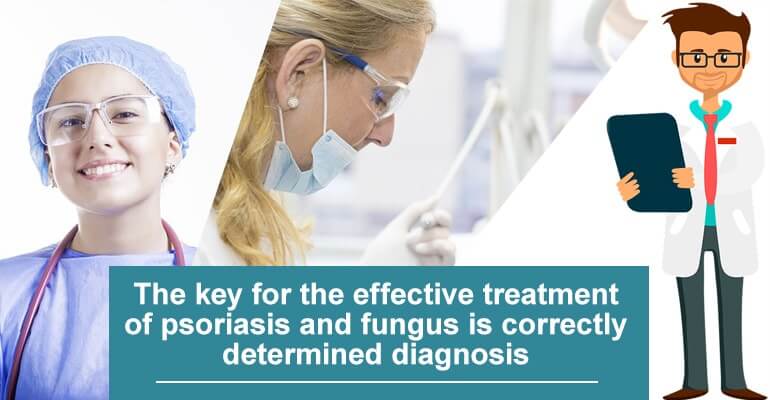Our hands can tell about the lifestyle we live, habits we have, and most importantly, about the state of our health. Changes in the nail structure can be a sign of numerous diseases that are difficult to determine. Let’s talk about the differences between nail psoriasis and fungal infection, or onychomycosis.
Nails are the appendages of the skin, the hard horn-like envelopes covering the tips of the fingers and toes. They consist of the protein keratin, which provides their solid structure. The main role of nails is protection.
Nail psoriasis occurs in 50% of patients suffering from psoriasis. For unknown reasons, fingernails are the more often affected areas.
Violation of the nail structure can be caused by autoimmune disorders, metabolism, and other complex biochemical processes. The disease is chronic with periodic relapses. It cannot be cured completely.
Onychomycosis, or fungal infection, is an infectious disease of mycotic origin. It is caused by fungi Trichophyton.
Usually, it is related to poor personal hygiene: sharing personal hygiene products, visiting public steam rooms, saunas, swimming pools, etc.
Often the toenails are also affected. The disease can be cured by properly following all medical recommendations.
The nail structure significantly changes under the influence of external and internal factors. In the case of psoriasis and fungal infection (onychomycosis), the symptoms are very similar:
It is necessary to correctly determine the symptoms of psoriasis and nail fungal infection.
| Criteria for distinction | Psoriasis | Onychomycosis |
|---|---|---|
| Nature of the disease | chronic autoimmune | fungal infection |
| Contagiousness | non contagious | can be transmitted |
| Localization | the nails on the hands and toenails | mostly toenails, rarely the hands |
| Presence of smell | absent | unpleasant odor |
| Color of the nail plate | yellow | dark color, greenish, pearly hue |
| Structural lesions of the nail | – at the initial stages dark dots on the nail plate are formed; – formation of white spots; – deformation of the nail plate; – the nail plates are thickened and separate from the nail bed, forming some niches where pathogenic bacteria and fungi can settle; – a symptom of an “oil stain”. | – can hit one nail plate, – gradually hitting all the others; – the edges are jagged and crumbled; – the presence of hyperkeratoses. |
| Spreading to other skin areas | May be accompanied by eruptions on the body | Nail plates on both legs can be affected |
It so happens that psoriasis can be accompanied by a fungal infection due to disruptions in immunity, metabolism, and other changes. In those cases, additional diagnostic methods might be needed.

Microscopic examination of a piece of the affected nail is needed to determine the pathogenic fungal flora that accompanies psoriasis.
The identical symptoms often lead to incorrect treatment. You should immediately contact a specialist. Only a doctor can differentiate and determine the reason for pathological changes. Self-treatment not only leads to a useless waste of money and time, but also causes various complications.
The difference between the treatment methods:
| Psoriasis of the nails | Onychomycosis (nail fungus) |
|---|---|
| there is no complete cure | therapy lasts up to six months |
| symptomatic treatment (antihistamines, hormones, sedatives, etc.) | oral intake of antimycotic drugs |
| local application of ointments with antihistamine, hormonal properties | external application of antifungal medicines |
| physiotherapy with the use of UVB lamp | treatment continues until a healthy nail plate grows |
| constant use of the same drug does not affect the quality of treatment | it is impossible to apply the same ointment for a long time, there is a risk of development of resistance of pathogenic flora to the medication |
| visit to dermatologist and an immunologist | dermatologist observation |
| the disease can’t be completely cured, high risk of recurrence | possible relapse in case of an untreated disease |
In the case of a combined infection (psoriasis and fungal infection), the physician selects a treatment according to the condition of the patient. There is a possibility of combining several drugs..
Prevention of diseases is an effective method of treatment. Nail psoriasis and fungal infection is no exception, however, there is a difference in preventive measures.
Ignoring pathological changes, not going to a specialist in time, and self-treatment lead to the development of complications. It delays the period of remission and can provoke a relapse in either case.